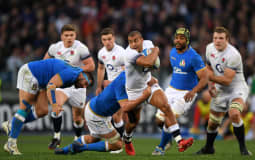(estimated 4 minute read time)
The Six Nations Championship, commonly known as the Six Nations, stands as an annual competition in the world of rugby union. The Six Nations unites the six European rugby nations, including England, France, Ireland, Italy, Scotland and Wales. With a legacy dating back to 1883, the tournament is one of the most anticipated events in the international rugby calendar and is eagerly awaited by fans worldwide. In this guide, we will explore the Six Nations’ rules and regulations that keep the games in check.
Six Nations Format
The Six Nations is a round-robin competition in which each of the six participating teams plays every other team once during the tournament. This results in each team playing a total of five matches over seven weeks, typically beginning in early February and concluding in mid-March. The format means fans get to witness some exhilarating rivalries play against each other, like England vs. Ireland.
KICK-OFF AND MATCH DURATION
A standard Six Nations match consists of two halves, each lasting 40 minutes. There is a 10-minute halftime break in between. Matches typically kick off in the early afternoon or early evening.
Six Nations Points System
The Six Nations uses a points system to determine the championship standings. Teams can earn points in the following ways:
- 4 points for a win
- 2 points for a draw
- 0 points for a loss
- 1 bonus point for scoring four or more tries in a match
- 1 bonus point for losing a match by 7 points or less
These points are accumulated throughout the tournament to determine the final standings.
SIX NATIONS RULES & REGULATION
DISCIPLINARY RULES
The Six Nations adheres to World Rugby’s disciplinary rules, which govern actions such as high tackles, dangerous play, and foul play. Referees have the authority to issue yellow cards (sin bin) or red cards (sending off) for serious infractions.
REFEREEING AND MATCH OFFICIALS
The tournament employs experienced international referees to officiate matches. These referees, along with assistant referees and the Television Match Official (TMO), ensure that the rules of the game are upheld and that the matches are played fairly.
Tiebreakers
In the event of teams finishing with the same number of competition points, tiebreakers are applied in the following order:
- Points difference (total points scored minus total points conceded).
- Total tries scored.
- The team that achieved the highest number of match points in their head-to-head encounter.
Grand Slam
A Grand Slam is achieved when a team wins all their matches in the tournament, earning a total of 20 points. This is a significant accomplishment and is highly regarded in the world of rugby.
Home and Away Matches
Each year, teams alternate between having three home matches and two away matches or vice versa. This ensures that teams get a fair chance to showcase their skills in front of their home crowd.
Substitutions
In the Six Nations, teams are allowed to make up to eight substitutions during a match. This rule enables teams to replace players on the field to manage factors such as fatigue, injuries, or tactical adjustments.
SIX NATIONS TRADITIONS
Wooden Spoon
The Six Nations Wooden Spoon is a symbolic “award” given to the team that finishes at the bottom of the Six Nations Championship standings. In rugby, this means the team with the least successful performance, having won the fewest matches or accumulated the fewest points. While it’s a tongue-in-cheek recognition, receiving the Wooden Spoon is generally considered a disappointing outcome for the respective team.
National Anthems
Before kick-off, teams assemble on the field to sing their national anthems. This tradition amplifies the ambience of the tournament, creating an electrifying atmosphere where fans unite and show support for their respective teams.
Kick-off and Match Duration
A standard Six Nations match consists of two halves, each lasting 40 minutes. There is a 10-minute halftime break in between. Matches typically kick-off in the early afternoon or early evening.
The Calcutta Cup
The Calcutta Cup is a prestigious rugby trophy contested annually between England and Scotland as part of the Six Nations Championship. The cup is one of the oldest trophies in international rugby, with its origins dating back to 1879. It was crafted from melted-down silver rupees, which were used as currency in Calcutta, India.
OTHER SIX NATIONS CHAMPIONSHIPS
WOMEN’S SIX NATIONS
The Women’s Six Nations is a parallel competition for women’s national teams, which follows similar rules and regulations to the men’s tournament. It has gained popularity in recent years and provides a platform for top-level women’s rugby.
UNDER-20 SIX NATIONS CHAMPIONSHIP
The Six Nations also actively fosters the growth of young talent in rugby through its commitment to youth development. Running alongside the senior tournament, the Under-20 Six Nations Championship provides a platform for emerging players to gain valuable experience, underscoring the tournament’s dedication to future rugby stars.
To conclude, the Six Nations Championship stands as a pinnacle of international rugby. The Six Nations rules are in place to uphold the integrity and competitiveness of the sport, serving as the foundation for a tournament that unites nations. Whether it’s a quest for the Grand Slam, the intensity of rivalries, or the sheer excitement of top-level rugby, the Six Nations never fails to deliver thrilling action on the pitch. It’s a must-watch for rugby enthusiasts and a source of national pride for the participating nations.
Discover the complete beginner’s guide to rugby rules.
If you’d like to experience the Six Nations in true luxury, take a look at our selection of official Guinness Six Nations Hospitality Packages, or step into our exclusive hospitality suite, The Green Room.











